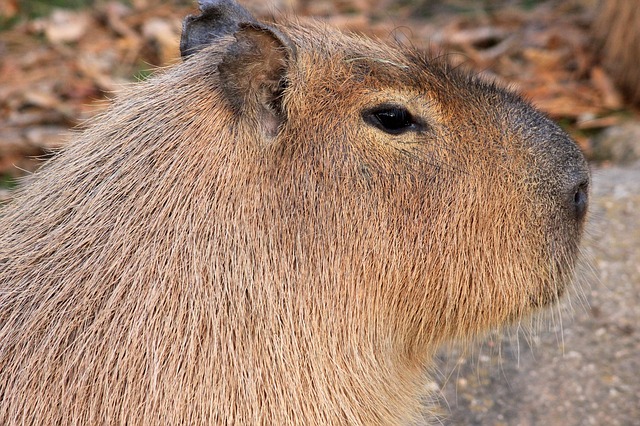It’s easy to bring you cool Capybara facts about what is considered to be the world’s largest rodent, standing about 1.5 feet (50cm) tall at the shoulder, 4 feet (130 cm) in length, and weighing about 75-150 pounds (35-70 kg). capybaras are closely related to other South American rodents such as Chinchillas and Guinea Pigs.
Semi-aquatic, they spend a lot of their time in the fresh water, even for procreation. They inhabit southern Central America and northern South America in both savannas and rain forests near ponds, rivers, or lakes.
Capybara Fun Facts
The Capybara has short, sturdy legs with four hoof-like claws on their front feet and three on the rear. The toes are webbed and help the Capybara with swimming.
A Capybara’s eyes, ears and nostrils are all positioned on top of the head, giving them access to excellent sight, sound and smell while in the water. When threatened, the Capybara can lower itself into the water, leaving only these parts of it’s body exposed to hide from potential predators.
What do Capybaras eat?
The Capybara’s diet is highly fibrous and consists of grasses and aquatic plants, along with fruits and berries. They generally eat about 6-8 pounds (3-3.5 kg) a day. Capybaras also eat their own droppings – an activity called coprophagy, which allows them to ingest a higher percentage of proteins and other nutrients.
Capybaras are social animals and live in small family groups of about 10-20. A typical group includes one dominant male, several females, their offspring, and a few subordinate males. The subordinate males act as sentinels, performing warning barks when a potential predator is near.

Usually, a group of capybaras has a ratio of one male to two females. Juvenile males are sometimes forced out of the group once they reach sexual maturity, leaving them to fend for themselves. Being the dominant male has several advantages. Not only does he enjoy a position toward the center of the group, safer from predators, he also mates with all the females in the group.
The Capybara sleeps very little, preferring instead to doze while resting during the morning in thickets on the banks, or wallowing in the mud and water when cooling down in the heat of the midday sun. They begin to emerge onto land in the early evening when they graze on grasses and aquatic plants which the Capybara will continue to do throughout most of the night.
What does a Capybara Sound like?
When the Capybara senses danger, it alerts the others with a “bark”, causing the herd to quickly hide in the water. The Capybara can hold its breath for up to five minutes under water, leaving only their eyes, ears and nostrils exposed until the threat has passed.
Capybara communicate between one another using scent secreted by their glands, and sound. They have a number of different vocalizations which includes whistles, barks, grunts and squeals.
See also: Is Florida About to Be Swamped With Capybara?
More Interesting Capybara Facts
Capybaras mate in the water, usually during the rainy season in April and May, although breeding can occur all year round, depending on the conditions. The female capybara will give birth to from 4 to 8 pups on land, following a 5-month gestation period. The babies will join the rest of the group, where they are communally nursed by all the females. In this way, all the offspring in the group stay together.
Capybara young are very well developed at birth and not only have all their fur and can see, but are also able to run, swim and dive within hours of birth. Although the babies begin to eat grass after about a week, they will continue to suckle milk from their mother until they are around four months old.

Like all other species of rodent, the Capybara’s two front teeth grow continuously throughout their life, so they have to grind them down by gnawing and chewing their food.
Capybaras can live 8-10 years in the wild, and around 12 years in captivity.
Capybara Predators and Threats
Wildcats including Jaguars, Pumas and Ocelots are the primary predators of the Capybara along with Caimans and Eagles that can hunt the younger ones from the sky above. The Capybara is also one of the best sources of food for the world’s heaviest snake, the Anaconda, along with other species of large snake.
The Capybara is also hunted by humans for both its meat and the hide.
Capybara Conservation Status
Although capybaras are currently considered by the IUCN Red List to be of least concern of becoming extinct, their populations have been largely affected by hunting in the past. People eat capybara meat and produce leather from their skin. In the countries where capybara populations started to dwindle, hunting restrictions were enacted, and capybara numbers stabilized. Habitat loss also affects Capybara populations through Central and South America.

Sources for Cool Capybara Facts: Animal Fact Guide, and Wikipedia
Video Source: Animal Planet
C is for Cool Capybara Facts : A-Z Collection of Animals #wildlife, #exoticPets Share on X
***
I hope you have enjoyed, “C is for Cool Capybara Facts“
You might also enjoy, “Rock Hyrax : Hyrax Closest Living Relative to the Elephant?“
*
A QUESTION FOR YOU: Tell me what animals you would like to learn more about.
Do you have a story you’d like to share?
*
***Leave a comment below and remember to share. ***
*
It’s just sexy!
*
As always, thank you for taking the time to visit
Animal Bliss


♥ PEACE ♥
*
- Mindful Travel With Your Dog This Holiday Season - December 23, 2019
- A-Z of Australia’s Endangered Wildlife - December 20, 2019
- Teaching Your Kids How to Walk the Dog Safely - December 2, 2019

Hey there! I’ve been reading your blog for a long time now and finally got the bravery to go ahead and give you a shout out from Dallas Tx! Just wanted to tell you keep up the fantastic job!
I’ve read some good stuff here. Certainly worth bookmarking for revisiting. I surprise how much effort you put to create such a wonderful informative website.
These cute lil guys are my favorite to watch at th zoo. They are free to roam the tropic building and come out from under the foliage. It would be a complete thrill to see them in their natural habitat. It’s interesting to note that they do not sleep much.
I’ve never actually seen one, Daphne, so it’s cool that you have. I think they’d make a really cool pet, don’t you? 🙂 Thanks for visiting my blog! It’s your first time here, I think. I hope it won’t be your last. 🙂 Peace
I’ve actually never heard about Capybera’s before, they are pretty cool. I love coming to your site and learning about new animals 🙂
These critters fall into the “so ugly they are cute” catagory.
Life & Faith in Caneyhead
I am Ensign B ~ One of Tremp’s Troops with the
A to Z Challenge
Well, I think they’re cute. lol I appreciate you taking the time to visit my site today, Barbara. Thanks for the comment and the links too! Have fun with the A-Z Challenge!
Oh, my gosh! I love Cabyberas. They are fascinating to me. This is such a fun challenge.
Yes, it is fun, isn’t it? Hmm … Who Delia? I guess I’ll just have to go over there and find out! Thanks for visiting! I’ll see you around, I’m sure. 🙂
Oh my Goodness! That is the cutest ever! How interesting they are, thanks for sharing all those neat fact about them!
I’m glad you enjoyed learning about the cool capybera, Sara. Thanks so much for stopping by! Come again! 🙂
Very cute, I love animals so I am really enjoying this
Awesome, Christa! I’m glad you’re enjoying this! 🙂 Come back soon!
What a cool rodent!! LOL, did I really just say cool and RODENT in the same sentence?? 😉 Love this blog and learning new things about animals.
I know … cool rodent. It’s almost an oxymoron. I’m glad you’re loving this blog and especially learning new things about animals, Alicia. That’s what I’m here for! Come back soon!
Wow! It is a big Rodent! Learned a lot about it though. Can’t believe that is a rodent of all things.
As I See It Daily
I know, it’s almost too cute to be a rodent. I just looks like a giant hamster. I’m really glad you stopped by, KaTy! I enjoyed your post, “Ca Ca Ca Camera,” too! All the best!
Cool! I saw a Capybera at BlogPaws last year.
Wow! I Love The Capybera!! So Freakin Cute!!!! Thank you, Now I know more about them Than Ever!!
Haha. I’m glad you enjoyed the post, Tara. I love learning new things about critters and especially love to share them with my readers! The cuter, weirder, longest, shortest, biggest, smallest … You get the idea … the better. Take care! 🙂
So enjoying reading your A-Z posts of all the different animals. Interesting Capybara facts! An animal I have heard of but didn’t know much about.
I’m really glad you took the time to check out my post about Capyberas, Marie! They’re a little different than our typical rodents! I think they’re cool. Take care! 🙂
That was an insightful post. Got to know so many new things about the cool lil’ Capybera 🙂
Hope you are having a great time reading, writing and networking with co-participants of the A to Z Challenge. Cheers 🙂
Co-Host AJ’s wHooligan for the A to Z Challenge 2015
Yes, I am have a great time doing the A-Z Challenge, Shilpa! Thanks for asking, and especially thanks for stopping by to read about the cool lil’ Capybera. Cheers! 🙂 I just started a Pinterest Group Board for the A-Z Challenge. Every topic, every theme welcome! If you’re interested in joining us in a group share, email me at jeanne@animalbliss.com with your Pinterest name or email. Thanks! 🙂